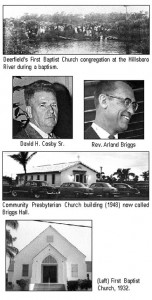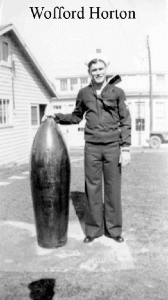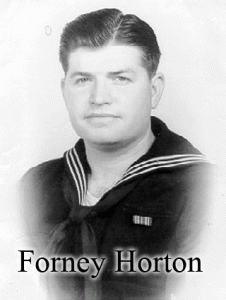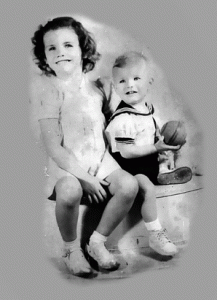Historical Essay 20
In 1944 Presbyterians “arrive” in “Baptist” Deerfield
Published: 13 Sep 2007
Up until the mid 1940’s the only formalized church in Deerfield was the First Baptist Church. Founded in 1910, the small congregation started meeting at the home of Mr. and Mrs. Robinson, whose home stood at where the Midas Muffler shop is today on the south side of Hillsboro Avenue, just east of Dixie Highway. Mrs. Robinson was actually a Methodist, but was very active with her Baptist husband in the Baptist church, but never actually joined it. This is probably because in order to join she would have had to have gotten re-baptized by immersion, as opposed to sprinkling, which is the method of the Methodists.
By 1912 the congregation had grown to 12 adult members, officially joined the Southern Baptist Convention of churches, and called the Rev. Samuel S. Gibson to be its first pastor. By 1914 the church had grown to an average attendance of 33 and had built its first sanctuary adjacent to the present site of Kraeer Funeral Home. The church was doing well until blown down by the huge “killer” hurricane of 1928. However, by 1932, a second church capable of seating 75 was constructed in the 700 block of S.E. 2nd Street across the street from Deerfield Elementary School. My parents, Marlin and Lorena Eller, joined the church in 1934, when both were 18 years of age. They were baptized in the nearby Hillsboro River, which was the custom then because the small church building did not yet have a baptismal pool.
On New Year’s Day, January 1, 1941, prisoners from the local jail were being used to clean the city cemetery behind the church. It must have been cold because they made a fire from the palm fronds they had gathered to keep warm. A sudden wind came up and blew fire debris onto the dry wooden shingle roof of the church, causing it to catch on fire. With their church badly damaged, the congregation decided to build a new, larger church to seat 200 people next door, and repair the old church and use it as a parsonage. This worked until 1960, when the congregation had outgrown that church and built the present church to seat 500, plus a large gym and Christian Life Center.
Meanwhile, Presbyterians and other faiths were coming to Deerfield. David H. Cosby, Sr. from New Jersey arrived in the mid 1930’s with his wife from Ocala, Florida. They had both worked for AT & T and apparently knew how property could be obtained for rights of way and other purposes. The effect of the 1928 hurricane and the depression that followed here meant that many people owning property locally could not pay their ad valorem (property) taxes. When ad valorem taxes are not paid on a piece of property, the county government allows others to pay the taxes with an interest charge added, and get a tax lien on the property. If the taxes and interest are not paid within about three years, the government allows the owner of the tax lien to go through a legal process, which allows them to ultimately get clear ownership of the property. David Cosby, an expert at this, was very interested in Deerfield’s beach area, and essentially arranged to buy most of it through the tax lien process within a few years. He developed the shopping Center in the “S” curve on A1A, but sold most of the rest of the beach to others for millions in profits over the ensuing years.
A devout Presbyterian, he donated the land in 1944 for the Presbyterian Church to be built on the beach, and became one of the first elders. The first church building was completed in 1948 and is now named Briggs Hall, after the Rev. Arland Briggs and his wife, Margaret, who served there from 1952-1981.
In 1974, Dr. Briggs gave recognition to four charter members after 30 years of church membership. Three of them: Susanne Glattli Anderson, Bertha Glattli Cosby, and Barbara Glattli Morrison, are related to our family, the Eller family, through the marriage of my son, Dana to their grandniece: Heather Glattli Eller.
David Eller, Publisher
Historical Essay 19
Mother’s brother, Uncle Forney Horton “Buys” the Cove Section of Deerfield Beach for $1500/acre!
Published: 23 Aug 2007
My mother had two younger brothers who served in the military during World War II. They were close in age, only a little over a year apart. The oldest was named California Horton. My maternal grandmother, Etta Clem Horton, had gotten pregnant with him just about the time she and Granddad Horton had planned to leave their cotton farm in south Alabama and move to California. Granddad told her they couldn’t leave for California with her pregnant. So they stayed and planted another crop of cotton. Grandmother got her frustrations out, however, by naming the baby boy, born on November 19, 1919, “California” Horton. He was quickly nicknamed “Forney”.
The cotton crop must have been good that year, or the weather real cold, because Forney was quickly followed within a year by a younger brother, whom they named “Wofford.” With two little boys nursing at the same time Grandmother never made it to California. The two boys grew up inseparable, more like twins than just brothers. My mother, Lorena Horton, three years older than Forney, and four years older than Wofford was their big sister, mentor and friend.
Forney was 22 years old and Wofford 21when World War II started. They both decided to join the U.S. Navy, hoping to serve together. However, the U.S. Navy was not as enthused as they were about them serving together and promptly, after basic training, sent Uncle Wofford to serve in North Africa and Uncle Forney to serve in the Pacific.
Uncle Wofford’s job initially was on a ship that picked up German prisoners of war from Field Marshal Erwin Rommel’s Deutsches Afrika Corps and brought them to the United States to military prisons. He once told me that he was surprised and a little intimidated to see such a bunch of good looking young men, mostly blond, blue eyed and muscular, but well behaved as they organized themselves by rank and marched on board the U.S. Navy prison ship. He also told me that one day he and a Navy buddy decided to taunt some of the prisoners as they were coming up the gangplank by shouting down at them: “Where’s your man Hitler now?” Suddenly one of the prisoners looked up at them and in perfect English shouted back: “Hitler is probably doing the same thing your man Roosevelt is doing tonight. Eating a good meal, drinking some fine wine and sleeping in a soft bed!” With that Uncle Wofford gave him a “thumbs up” ….as they both smiled at each other. When the war was over Uncle Wofford bought a Texaco Service Station in Brewton, Alabama, about one hour’s drive north of Pensacola, Florida. Over the next few years he parlayed that into 15 more gas stations in Southeast Alabama, plus a Holiday Inn in Brewton.
Meanwhile, Uncle Wofford’s brother, Forney, married Margie Rogers of Greenville, Alabama, simultaneously with joining the Navy. He was assigned to the Seabees, trained as a bulldozer operator, and shipped to the South Sea Pacific islands. His main job was to help build airports and roads on the islands that the U.S. Marines and Army had captured from the Japanese. However, the military also sometimes used the bulldozers as offensive weapons. Apparently that was part of the battle-plan, to bury the enemy alive in their caves with bulldozers. However, Uncle Forney was wounded once in hand-to-hand combat with a Japanese soldier who objected to his cave opening being covered over by the sand that Uncle Forney was pushing with his bulldozer. Several Japanese soldiers suddenly came out of the cave as it was being sealed, with bayonets flashing. Forney joined the Marines to repulse them, but one enemy soldier was able to swipe him across the belly with his bayonet before being shot down by a Marine. A relatively shallow wound, and Uncle Forney was back on duty within a few days.
Uncle Forney regularly sent letters to my mother, Lorena, and his wife, Margie, letting them know how things were going in the Pacific. Apparently things were going quite well after the initial battles, and he was having fun on those Pacific islands. In fact, he couldn’t help himself from bragging to my mother about some escapades he was having with some of the island girls. He even had a friend take a picture with him and a scantily dressed island girl embracing each other in a very suggestive manner. His intention was to send the picture only to my mother. However, he had simultaneously written a letter to his wife, Margie, describing how difficult life was over there. Unfortunately for Forney, he put the picture of himself and the island girl in the envelope addressed to his wife; and sent my mother the letter he’d intended for his wife. When mother received the letter meant for Aunt Margie, she knew immediately that there was a big problem brewing for her little brother. Aunt Margie was really upset when she opened the letter with pictures of her husband with the island girls, and decided to get even with him by eating. By the time the war was over, and Uncle Forney came home, she weighed about twice as much as she had weighed when they had gotten married. Unfortunately, she maintained that weight the rest of her life.
Uncle Forney was discharged from the Navy in November of 1945 and promptly moved to Deerfield Beach to work for my father. While working as a welder and mechanic for Dad for a year or two, he simultaneously studied to get a real estate and broker’s license. As soon as he received that license he resigned his job with Dad and opened up a real estate company on North Federal Highway in Boynton Beach, naming it “Boynton Realty”. He was phenomenally successful.
In the early 1950’s he made one of the largest sales ever recorded in Deerfield Beach. He was the real estate agent/broker who sold the 500 acres between US Highway No. 1, and the Intracoastal Waterway, from Hillsboro Avenue to what is now Lighthouse Point, the area now called “The Cove”, to housing developer Bob Sullivan for $1,500 per acre. It was purchased from the Kester family of Pompano Beach. More of how that sale happened, and the role that my father Marlin Eller played, will be described in future Historical Articles.
David Eller, Publisher
Historical Essay 18
Life throws me a curve at age 2 1/2
Published: 9 Aug 2007
In the spring of 1944, when I was 2 ½ years old, my mother took me with her to visit a friend in Boca Raton who had a son five years old. His name was Jimmy, and his last name started with a “B” and ended with an “N”; but I’d rather not fully spell it so as not to embarrass anyone. Anyway, he and I were playing, and I was probably teasing him, when he suddenly grabbed me by the ankles, lifted me up high in the air and slammed me down hard to their living room wood floor on my back. I landed with the bottom of my neck hitting first, followed by the back of my head, knocking me unconscious.
When I didn’t move for a few minutes, my mother picked me up and rushed me to the Good Samaritan Hospital in West Palm Beach, which was the closest hospital at the time. Mother later told me that I was unconscious for quite a while. When I finally awoke at the hospital, but still didn’t move, the doctors discovered I was paralyzed from the neck down. My five-year-old friend and his parents were devastated, of course, as were my parents and sister. They kept me in the hospital for a while, trying to get me better, but apparently nothing was working. Mother and Dad were praying real hard, of course, as were many of their friends and relatives in Deerfield.
One day, my father’s sister, Nova Adams, brought her 3-year-old daughter, Sandra, to visit me in the hospital. Unbeknown to anyone at the time, Sandra had been exposed to whooping cough, and was just beginning to experience the effects. When she arrived at my bedside, according to my mother, little Sandra leaned in through the bed railing a far as she could, to look at me up close. Suddenly she coughed loudly right in my face. Mother quickly pulled her away and politely suggested that Aunt Nova take her home since she appeared to be sick. Mother was not happy that someone brought a sick child to visit me.
She and Dad continued to pray, and Mother remembers asking God why He would allow a sick child to be brought to my bedside, exposing me to even more danger. A few days later I started to cough, and the doctors said I had caught the whooping cough too. Mother and Dad were frantic.
I would surely die now, they thought.
But something was happening to my body as I coughed. Suddenly I started moving my legs. Then I moved my left arm, and later on my right arm. I was getting better. I was overcoming the paralysis. My mother always believed that it was a God thing and he had sent little Sandra to visit me with the cure I needed: whooping cough.
The doctors apparently could not figure out what was happening with me.They tested me for polio, which was rampant at the time, but the tests were negative. Eventually they discharged
me from the hospital, but requested mother to bring me back to see Dr. Martin once a week at the “Children’s Clinic” in Palm Beach. Those appointments continued on for several years, but eventually dropped to once every two weeks. I never felt sorry for myself because nearly every other child I saw at the clinic was really bad off. Some were even in iron lungs, which was a round cylinder device with only their head sticking out.
I remember getting back and right arm massages, and sometimes they would wrap me in a smelly brown blanket and put me in a hot tub of water. One day my mother got really mad at the nurse who was massaging me. She and the nurse had been talking about “the war” in Europe. The nurse, who had an accent, told Mother that she was from a place called Normandy in France, and that she was worried about her house there. She went on to say that she preferred the Germans to be there because they would take better care of her house than the Americans. My mother’s face got red as she told that nurse that one of her brothers was there and she did not appreciate what the nurse had said. Then Mother went to the clinic supervisor and told him she did not want that nurse working on me. I never saw that nurse again.
Eventually, they said I only needed to come once or twice a year. That was good. However, I remember Dr. Martin telling Mother and Dad that when I reached twelve years old, he wanted me to have a special examination. At the time I didn’t realize how special it would be, nor how it would affect my life for several years thereafter.
-David Eller
Historical Essay 17
The World War II years in Deerfield Beach
Published: 26 Jul 2007
In the last Historical Essay, No.16, I introduced myself as the newest citizen of Deerfield Beach; born on October 2, 1941. It was just a few weeks before the December 7, 1941 Japanese attack on Pearl Harbor, and I always suspected that I was planned by my parents to put my Father, Marlin, age 25 at the time, further back in the line of military draftees. It seems the government drafted the single men first, then the married men with one child, then two children, etc. However, my parents denied that was the case, but always smiled many years tater whenever t would bring it up.
Regardless, my father was never directly in the military during World War II. However he was on the list next to be called if President Truman hadn’t dropped the big bomb in 1945. Maybe that is why Dad always thought Harry Truman was our best President.
However, Dad did contribute to the war effort by utilizing our company facilities and manpower to help maintain the equipment at the new Army Air Force base in Boca Raton. I remember being told that he received an official letter from the Army ordering him to put any of their needs in front of civilian needs for a certain period of time.
The Army had also taken over the Boca Raton Hotel at the time to house military pilots in training. Dad was also on call there to fix or repair anything needed by the Hotel. This obligation endeared him to the Hotel’s maintenance managers, which continued many years after the War. In fact I personally remember when the big hurricane of 1947 occurred, the Hotel managers invited Dad and our family to leave the insecurity of our little wood frame house on Dixie Highway in Deerfield, and stay in the big sturdy Boca Raton Hotel for the duration of the storm. It was neat to be there, but our room felt like a dungeon because it was dark and cold and there was no electricity once the winds started howling. Dad helped them fix things as the wind and rain did their damage.
Meanwhile, back to the war years, Dad also had a nighttime job at the Boca Hotel. He played guitars and sang in the Hotel band that entertained the soldiers. He played both Hawaiian and acoustic style guitars. Mother also sang in the band sometimes and they did duets together. They made a number of lifelong friends from the soldiers who passed through, many of who came back here to live after the war.
I have relatively few memories from those early years. However, I remember there was an airplane that crashed in the woods about 100 yards east of our house, which would put it in the middle of present day Pioneer Park. Years later my friends and I would still find pieces of it scattered around the area. I also have vague wartime memories of soldiers marching down Dixie Highway in front of our house. I remember the distinctive thud sounds of their boots striking the pavement, and the sight of them in their uniforms as I peeked through our white picket fence in the front yard. Occasionally a soldier would see me, grin and wave. I would give him my biggest smile and excitedly wave back.
-David Eller

Historical Essay 16
Owen McDougald
Published: 12 Jul 2007
After several years of requests from friends and family, I started writing these historical essays in the fall of 2006. It has taken 15 essays over nine months to get from my Grandfather Hoyt Eller’s arrival in Deerfield Beach in 1923 to the point historically where I was born on October 02, 1941, and became Deerfield’s youngest citizen. Well almost the youngest. It was actually a tie. Owen McDougald, who was destined to become one of my best early childhood friends, was born the same day at the same Good Samaritan Hospital in West Palm Beach. But his mother died in childbirth. His mother was a good friend of my mother. My mother for some reason used to feel guilty that her friend died, while mother lived through child birth, and was able to take me home.
Owen’s father was a farmer and Owen was his only child, which now had to be raised alone. The two of them lived in a large wood frame house painted gray, south of the present day US Post Office, about half way between Hillsboro Boulevard and 10th Street. However, before Owen was six years old his father also died, making Owen an orphan.
Owen was then “adopted” by an uncle, a County Deputy Sheriff by the name of A.J. Peterson and his wife (also a deputy sheriff). They lived across the street from Deerfield Elementary School’s northwest corner in the “Kester” house mentioned in the previous essay. However, Deputy Peterson and his wife were having some marital problems. Not too long after Owen moved in, as a small child, the Petersons got into a serious argument, shots were exchanged and one of them died. Owen became an orphan for the second time. Other relatives got involved this time, and using the money from his father’s estate arranged for Owen to go to a military school for boys up in Georgia. From then on we only saw each other for a few weeks every summer when he came “home” to visit. His story ends well, however, as when he grew up he married a pretty red head, had some children, and followed in his father’s footsteps as a horticultural farmer in Palm Beach County. He retired a few years ago with a considerable fortune made in nursery agriculture and real estate.
Meanwhile, I was the center of attention at the Eller household in Deerfield. They named me James David Eller, then proceeded to call me David. I had blue eyes with crinkles on the outside edges (which I still have). The quantity of my brown hair left much to be desired, but there was enough to make a little wave toward the front top (which I still maintain). But horrors of horrors, they then put me in a dress! Why? It seems that this was the custom back in those days. A custom, incidentally, that I’m pleased has disappeared with time.
My mother was knockout beautiful. Framed in black wavy hair, her face was a slightly lighter complexion than mine. This probably reflected the fact that on my Dad’s side, his Great Grandmother was a Cherokee Indian.
I was born just ten weeks before the beginning of World War Two. Therefore I used to wonder whether I was planned to keep my Dad from being drafted into the military. My parents always denied that, but their sly smiles when I would ask the question, gave them away.
I wish my parents had not named me James David , with the intention of calling me David. They should have named me David James if they intended to call me David. It would certainly have made my life a lot easier. Every time I do something official, like passing through an international airport, I’m called James. Often times I miss it when they call out that name. I complained once to my parents, but Dad explained that it was a family named which had continued for many generations. A few years ago I received a call from a man in California who was researching the Eller name. He explained that the name James, and/or Jessie, identified from which of the original immigrant brothers, our family was descended. I thanked him, and decided to stop complaining.
– James David Eller
Historical Essay 15
Deerfield was a small town…Boca Raton was a village
Published: 28 Jun 2007
The last two essays, number 13 and 14, featured two of my father’s largest customers for his pumps, farm implements and general machine shop work: the Butts family, and the Japanese Yamato farmers of Boca Raton. Between them they owned and farmed approximately 6,000 acres of what is now Boca Raton.
The Boca Raton Hotel owned much of the rest of the land in Boca, and was another major customer of my Dad’s. He provided the maintenance, welding and machine shop services for most of the equipment at the Hotel and their golf courses. Built by Mizner in 1926, the Hotel quickly went into bankruptcy and was bought by Clarence Geist of Philadelphia in 1927 who made it a private club. Most of the residents of Boca Raton at the time were dependent on Mr.Geist and his club for their jobs. To keep his hotel taxes down he organized his own employees, living in his own employee compound, into a majority voting bloc and quickly took over the town government. His control continued into the early forties when the federal government stepped in and made his hotel the housing for military officers being trained at the newly constructed Boca Raton airfield.
Meanwhile, Deerfield developed along a different path. A considerable amount of land in Deerfield was also owned by one family, the Kester family of Pompano. However, there were many smaller land owners and farmers in the Deerfield area such as the Butlers, the Jones, the Vickers, the Wiles, the Bournes, the Gaskins, the McDougalds, the Ellers and others. However the Kesters owned the most land and the only bank in the area: the Pompano State Farmers Bank. The Kester family also did some housing development. In fact most of the early homes in Pompano and Deerfield were “Kester homes”, and were distinguished by their clapboard wood siding, always painted white, with storm shutters of varying colors to distinguish them one from the other. You still see a few of them around today. In fact one is located across the street from Deerfield Elementary School’s northwest corner parking lot.
Incidentally, Deerfield got its name from the local Seminole Indians who hunted this area and named it Deerfield because it was a large flat meadow land heavily populated by local deer. And it may come as a surprise to many to learn that up until the 1940’s Deerfield had a considerably larger population than Boca Raton. Originally it was because the Florida East Coast Railroad (FEC) trains stopped in Deerfield along the south bank of the Hillsboro Canal to get water for their steam engines. The FEC built houses here for their employees who made sure the water tanks were always full. Because the trains had to stop, Deerfield became a convenient place to load and unload passengers, as well as to load farm products going north and supplies coming down south. Therefore many farmers, merchants and the likes ended up living in the town of Deerfield, which resulted in a school, three grocery stores, two hotels, some churches and various shops serving a population measured in the hundreds. Meanwhile, Boca Raton for much of its early history was just a village two miles north of the Hillsboro River consisting of a few dozen permanent residents who primarily shopped, worshipped and went to school in Deerfield.
David Eller
Historical Essay 14
Our Japanese Connection
Published: 14 Jun 2007
The last Essay, No. 13, featured the Butts family, who were my father, Marlin Eller’s largest customer at the time, and who owned some 3,500 acres in what is now Boca Raton. However, there was another large farming group already in the Boca area before Butts, who also did considerable business with my father. It was a group of Japanese farmers and their families who had been recruited by the Florida East Coast Railroad (FEC) to colonize the northern Boca Raton area and grow pineapples to be sent by railroad up north.
The FEC had made arrangements with a young Japanese man (named Jo Sakai) who had recently graduated from New York University and gave him an incentive to recruit Japanese farmers to the area. He was immediately successful as the Russo- Japanese war was going on at the time, and young Japanese men were anxious to avoid being drafted into their military by emigrating. The young farmers started to arrive by 1905 and they named their settlement Yamato, which roughly translates to “large peaceful country”. Yamato reached a population of about 40 people, and included the property now occupied by Florida Atlantic University plus somewhat north all the way to the ocean. It included a beautiful outcropping of rocks overhanging the Atlantic Ocean shoreline, which is still called “Jap Rock” by some old time locals.
Jo Sakai, Yamato colony founder and his wife Sada Sakai were wedded in an arranged marriage in 1907 in Japan after he had established the Boca Raton colony. She later shared with her daughter that she was very disappointed when she arrived to the colony and found it much smaller than her husband had described.
The Japanese immigrants grew pineapples and certain specialty crops and were good customers of my father. However, as WWII approached most of the immigrants left and returned to Japan. In May of 1942, those who were left were ordered by the United States government to vacate all their land in Boca Raton west of the FEC railroad so it could be turned into an airport and military facility. My dad recalled his main Japanese customer “George” Sukeji Morikami crying as he told my dad what had happened and simultaneously apologizing for what his former countrymen had done in attacking the United States at Pearl Harbor in December 1941.
George cried all the way to the bank, however, as he still owned considerable property which eventually netted him a fortune. He continued to farm his remaining land for many years, and I remember him coming in to our factory in Deerfield dressed in overalls and a straw hat to buy things for his farm and visit with my father into the 1960’s. Although apparently quite wealthy from farming and the landholdings he had sold, he continued to live hermit-like in a mobile trailer on his property. He was eventually granted American citizenship in 1967 at the age of 82, and showed his appreciation by donating the last of the property on which he lived for the South Palm Beach County Park, now appropriately named Morikami Park.
David Eller
Historical Essay 13
Efficient Pumps…make for lots of “beans for Butts”
Published: 31 May 2007
In Essay No. 11, it was explained how my Dad, Marlin Eller, at age 21, got started in his own manufacturing business in Deerfield in 1937 by buying his father’s machine shop for $900. It was located on Dixie Highway, where the tennis courts are now, across from City Hall. In Essay No. 12, Dad learned the hard way about the importance of getting patents when he saw his rotary seed planter invention scooped up by others.
Dad had developed the seed planter for his largest customer at the time, August H. Butts, of Butts Farm in Boca Raton and his two sons, Harold and Clarence. Butts Road in western Boca Raton is named after them.
When Harold Butts graduated from the University of Florida in 1933, his father already owned and farmed two 640-acre sections of land in Boca Raton. With Harold’s college-educated input, the family was able to grow the farm significantly. They gradually bought another 2,200 acres, and therefore owned and farmed nearly 3,500 acres, some six square miles, in what is now Boca Raton.
Town Center Mall, Boca Raton Square, Royal Oaks Hills, and many other western Boca Raton developments were built on the former land of Butts Farms. Incidentally, to help you visualize him, Harold Butts in his later years was a dead ringer for the patriarch of the Bonanza TV series, Ben Cartwright. He was a striking figure, especially on his horse, which most of the farmers rode in those days.
Dad worked with the Butts family closely and was their primary source for pumps and general machine shop needs. He helped them develop not only their irrigation system, but a number of specialized farm implements to help them grow their crops, which eventually became primarily green beans.
The pictures featured here and the quotes that follow are taken from the Boca Raton Historical Society Pictorial History Book, Edition 1990 by Curl and Johnson: “By building the best in irrigation systems and using the most up-to-date farming methods, the Butts Farm became one of the largest bean producers in Florida. In 1940, the farms regularly employed four hundred workers and added an additional five hundred migrant pickers for harvests. In that year they shipped 134,000 hampers, some three hundred boxcar-loads, from their own loading docks to the northern markets.”
“Harold Butts later said they purchased the additional land to keep other farmers from coming into the market and for the water. Pumps brought water to the cultivated fields from everywhere on the farm. The system was so efficient that the farm could sell surplus water to other farmers.”
Marlin Eller, my father, built those “efficient pumps”, and our company, now known as MWI Corporation / Moving Water Industries, still manufactures them, plus much more-advanced versions.
David Eller
Historical Essay 12
Dad, Marlin Elller learned the hard way
Published: 10 May 2007
Dad, Marlin Elller learned the hard way about the importance of getting a patent! In the last essay it way explained how my father Marlin Eller, bought his father’s garage on Dixie Highway in Deerfield, where the tennis courts are now, for $900 to start his own business at age 21 in 1937. It was already a small machine and welding shop providing services to the local farmers.
However, Dad had much bigger ideas. For instance, he had noted the frustration of the farmers trying to plant their seeds at a set distance apart so that one plant would not interfere with the other. Doing it manually was tedious work and difficult to manage. So Dad came up with an idea to place the seeds in a special bucket which could be pulled from behind a tractor. The bucket was built with two bottoms. The first held the seeds and allowed them to fall through a small opening at the outer edge of the bucket into the second bottom which was actually rotating in a circular motion, and contained evenly spaced seed sized openings. As the compartment with the seed turned through a mechanism timed with the tractor’s forward motion, it would drop the seed down a tube adjusted to place the seed evenly spaced every few inches laterally, and an inch or two below the soil surface. It was a brilliant idea which eliminated an enormous amount of labor and standardized the quality of the crop.
Dad started building these “seed planters” for the local farmers, but quickly realized that there was a much larger potential which would require much greater manufacturing capability. Thus he sent drawings of his design to all the main farm implement manufacturers in the Midwest and North asking them if they would be interested in manufacturing his new product.
He quickly received responses from some of them indicating a great deal of interest and suggesting they would like to come down and see it for themselves.
Dad was very proud. He invited them all to come and see for themselves his new product. They came, they marveled, they asked him if he had a patent! Dad did not. They smiled and went back north. Within a few months they all came out with their own “rotary seed planter”. They started selling them even in Florida at less than Dad’s cost for building them one at the time.
Dad learned his lesson well and he taught it to me, and I’ve taught it to my engineer children in the business: never reveal to others a unique new product idea on which you do not have at least a patent pending. About thirty patents and patents pending later, we still remember the story of Dad’s rotary seed planter, and we file a patent on every idea before introducing it to the market place. Not every patented product turns out to be financially successful. However, like Dad used to say: “we manage to keep food on our table with those that have been…”
David Eller
Historical Essay 11
Dad, Marlin Eller and Granddad Hoyt Eller split
-Dad buys the family machine shop for $900-
Published: 19 Apr 2007
The last essay ended with Dad, Marlin Eller, having entered the trucking business at age 18, in 1934, hauling bagged fertilizer from Port Everglades in Fort Lauderdale to the farms around Lake Okeechobee. He bought a large flatbed truck, but his father, “Pop” Eller, had to sign for the loan since Dad was too young to legally sign the promissory note required by the bank to borrow the money. Therefore, the truck was technically in Granddad Hoyt Eller’s name.
But Dad was doing well in the trucking business. He soon hired his first employee, an African-American nicknamed “Alabama”. Shortly thereafter, he bought two more trucks with Granddad still signing the notes. He was on his way as a young trucking entrepreneur, hauling fertilizer, making substantial bank payments, and still able to save enough money to buy a house.
It was a three bedroom, pre-fabricated wooden house which he and mother ordered from Sears Roebuck Company out of their catalog. He also bought a lot on the east side of Dixie Highway, directly across from his father’s house, where the present-day tennis court office is located, on which to build the house. As described in Essay No. 1, the house was made of clapboard wood, painted white, with red shutters, which actually could be closed and locked in place to protect us during hurricanes. A white picket fence established the grassed yard boundaries in the frontage on Dixie Highway, and on the south side next to the neighbor family Gaskin’s residence. The back- yard was open to what is now Pioneer Park, but then it was just open woods of pine trees, palm trees and palmetto bushes.
Granddad Eller’s “workshop” bordered our house on the north side. The house sat on short concrete piles about 18 inches above the ground with cypress beams and pinewood floors. This was because when the hurricanes and floods came in the summer, the Hillsboro Canal sometimes overflowed into our yard. Therefore, a small rowboat was left in the backyard to maneuver around during flood times.
The Army Corp of Engineers eventually solved that problem in cooperation with the South Florida Water Management District, and Dad was eventually able to retire the rowboat. He finished the house in 1937 and moved in, just in time for my sister, Linda, to be born in 1938. However, trouble had started brewing between Dad and his father Hoyt. It was over the trucks Dad had bought and paid for with his backbreaking fertilizer hauling business.
When Dad turned 21 in 1937 and made what he thought was his last payment on the trucks to the bank, he asked for the
titles, the bank refused. It seems that the bank considered the trucks still to be collateral for Granddad Eller’s farm loans. Dad was furious! He had paid for those trucks, not Granddad, and he wanted the title. The bank refused claiming it was part of Granddad Eller’s overall loan portfolio.
Unfortunately Granddad, had had a couple of bad years in his farming business, was apparently behind in his loan payments and was not able to get the trucks released from the bank either.
Dad, as they say, was fit to be tied. He was mad at the bank and mad at his father as well. Granddad Hoyt soon sold the trucks, however, and worked out a deal for my dad, Marlin, to buy the family “machine shop”, on the north side of dad and mother’s new house, for $900. Thus at 21 years of age, Dad had at last his own place of business from which to start making a living: building and repairing farm equipment – mainly pumps – for the local farmers.
However, Dad was still mad at his father, and unfortunately, never got over it, speaking to him only on special occasions. Eventually Granddad sold his Parkland farm and Deerfield home and moved to Boynton Beach, where he bought a substantial amount of land west of town for $52,000 on which to farm.
To be continued…
David Eller










